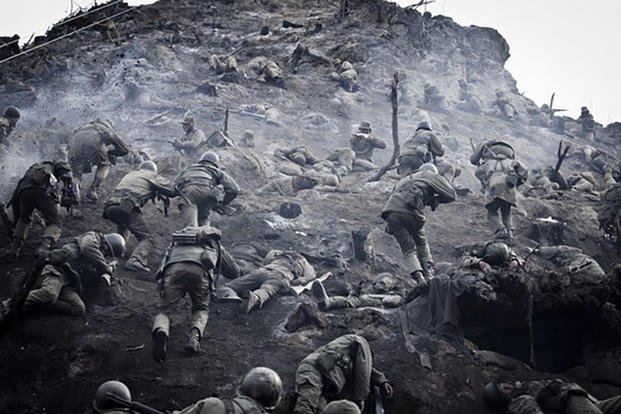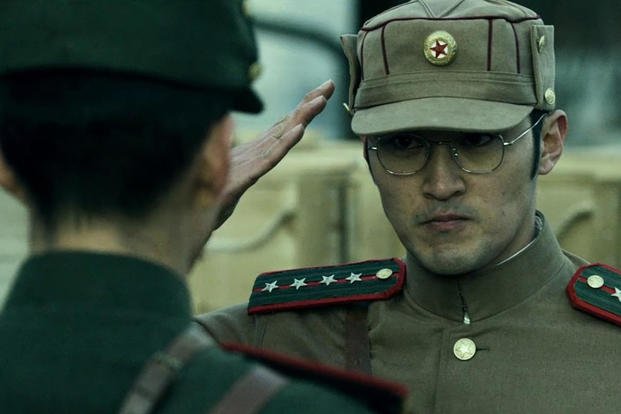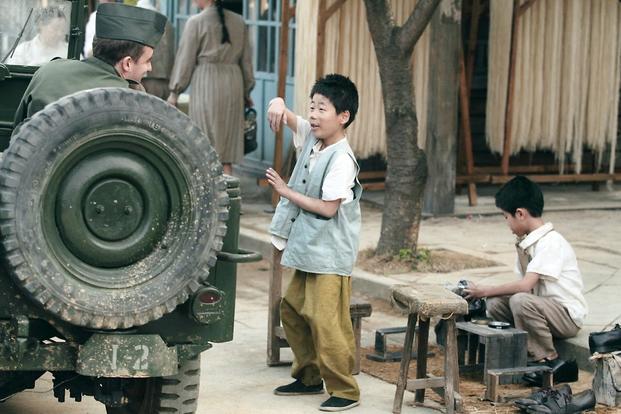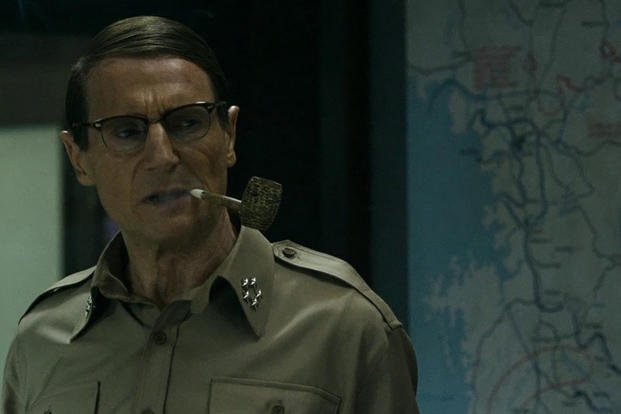For American audiences, the Korean War is often called “the Forgotten War.” But in South Korean cinema, it has never been forgotten. South Korean filmmakers have repeatedly revisited the war, not only to tell stories of heroism and tragedy but also to reflect on the country’s complex relationship with the United States.
Over the decades, South Korean war films have taken different perspectives on the country’s closest ally, mirroring shifts in public sentiment. Some frame the U.S. as a liberator and a critical partner, while others depict it as a prolonger of war. These films offer more than just action-packed battle sequences; they serve as windows into South Korea’s evolving views on its history, national identity and relationship with the U.S.
These four films offered starkly different portrayals of America’s role in the Korean War:
‘Welcome to Dongmakgol’ (2005): A Faceless War Machine
Capt. Neil Smith, an American soldier, is stranded in a village called Dongmakgol after his plane crashes deep in the mountains. The residents of this remote village lead a primitive life, unaware that the Korean Peninsula is engulfed in warfare.
North Korean soldiers, who are lost in the woods, are also led to the village, and two South Korean deserters stumble upon it while scavenging for food. Initially, the soldiers antagonize each other, but the villagers’ blissful ignorance gradually dissolves hostilities, leading them to lay down their arms. They farm and hunt together, and once the soldiers take off their military uniforms, they return to the innocent simplicity characterized by the villagers, who act as a metaphor for everyday Koreans living out the war.
Read Next: The 5 Most Realistic Army Movies, According to an Army Historian
However, after Smith’s plane crash, U.S. troops falsely speculate that a North Korean artillery battalion is positioned in the mountains. They send Allied troops to scout the area, who harass the villagers. As the harassment intensifies, the soldiers stranded in Dongmakgol take out the search party, which consequently is met with a retaliatory airstrike. In a tragic climax, the soldiers sacrifice themselves to protect the villagers.
The film received mixed reviews after its release. While some critics praised it as a post-ideological, anti-war film, the movie emerged at a time of heightened anti-American sentiment in South Korea after a U.S. military vehicle accidentally ran over two schoolgirls in 2002 and controversial remarks by then-president Roh Moo-hyun. Some critics accused it of provoking anti-American and pro-North Korean sentiments.
In “Welcome to Dongmakgol,” the U.S. is portrayed as a faceless military machine driven by war calculations rather than moral considerations. Its pernicious nature threatens the villages’ innocence and ultimately kills the soldiers. The ruthless airstrikes and the violence of the Allied troops underscore the idea that U.S. intervention is ultimately destructive.
‘The Front Line’ (2011): A Prolonger of War
First Lt. Kang Eun-pyo is dispatched to the front lines to investigate a mysterious case: A South Korean officer has been shot in the head by friendly fire. Kang arrives at Aerok Hill, where “Alligator Company” is locked in an endless cycle of capturing and losing the same piece of land.
Meanwhile, American, Chinese and North Korean commanders gather to discuss ceasefire terms, but negotiations are prolonged as the sides aim to acquire more land. The war enters a stalemate, and the weary, disillusioned soldiers prioritize survival over ideology.
Kang soon discovers that soldiers from both sides have been communicating through hidden caches in a bunker, exchanging supplies such as American cigarettes and North Korean alcohol, as well as letters meant for separated families.

Meanwhile, as Chinese troops join the war, South Korean forces suffer heavy losses. The company’s incompetent new commander, Capt. Yoo Jae-ho, orders a suicidal mission to retake the hill, prompting Kang’s friend, Kim Soo-hyuk, to shoot Yoo and take command himself.
As ceasefire negotiations unfold, a radio announcement declares the fighting will officially end in 12 hours. Yet rather than laying down their arms, both sides launch desperate final offensives, with U.S. planes indiscriminately bombing the battlefield and killing almost everyone on either side. In a climactic moment, only Kang and a North Korean commander remain in the trenches, but instead of fighting, they share a cigarette and reflect on the war’s meaning.
To Kang’s question about what the North Koreans fight for, the commander, who once believed in his cause, admits, “I did know before, but now I have forgotten.” As the ceasefire is finally declared, the two laugh in bitter relief.
“The Front Line” critiques the futility of war and challenges the romanticized notions of ideological struggle. The hill itself, Aerok (“Korea” spelled backward), symbolizes the Korean Peninsula — constantly fought over but ultimately unchanged. The U.S. is portrayed as a distant, apathetic force that prolongs the conflict for its own geopolitical interests. The Americans negotiate a ceasefire without South Korea’s involvement, and their airstrikes indiscriminately bomb the battlefield, showing little regard for their South Korean allies.
The film was criticized for allegedly sympathizing with North Korea and downplaying the sacrifices of South Korean veterans. Others praised its raw, unflinching portrayal of war’s senseless brutality.
‘Operation Chromite’ (2016): A Story of Altruistic Heroism
Starring Liam Neeson as Gen. Douglas MacArthur, “Operation Chromite” dramatizes the days leading to the Battle of Incheon, a decisive amphibious invasion that turned the tide of the Korean War. The film follows Capt. Jang Hak-su, a North Korean turncoat who infiltrates enemy lines to secure critical intelligence for the United Nations forces.
Jang — disguised as a North Korean officer — and his men must obtain a classified map of underwater mines before MacArthur’s forces land. After a tense series of deceptions and firefights, they sacrifice themselves to sabotage enemy defenses and ensure a successful landing for the U.S. troops. The film concludes with MacArthur saluting the fallen South Korean operatives as his forces liberate Incheon.
Although MacArthur appears sparingly, one key scene stands out. In a flashback, he encounters a lone South Korean child soldier who refuses to retreat without orders. Deeply moved by the boy’s bravery, MacArthur vows to “save this boy’s country.” Meant to resonate emotionally with the audience, this moment encapsulates the film’s portrayal of the U.S. as a benevolent ally committed to South Korea’s liberation.

Unlike “The Front Line,” which questions America’s motives, “Operation Chromite” celebrates its leadership and moral authority, but opinions are mixed. During a discussion for Center for Free Enterprise — a South Korean think tank — Kyonggi University professor Lim Jong-hwa describes the film “as an ode to the sacrifices made by veterans and our allies, which helped [Korea] maintain its core values, upon which today’s Korea was built.” The depiction of MacArthur leading a key victory that turned the tide of the war alone gives the film significance, Lim said.
But other critics, including Hwang Jin-mi, argue that the U.S. participation in the Korean War is overly glorified. They dismiss the movie as an “anachronistic anti-communist film” that idolizes MacArthur, promotes anti-communist values and demonizes North Korea.
“Is Korea’s goal today anti-communism or reunification,” Hwang wrote. “How different are we from 30 years ago … when dictatorships used anti-communist rhetoric to maintain their regime?”
‘Ode to My Father’ (2014): A Backdrop to the Korean Dream
This nontraditional war film is a tearjerker outlining South Korea’s postwar growth. The historical drama follows Yoon Deok-soo, a North Korean child refugee who fled to the South during the Korean War. As the eldest son, he shoulders the burden of supporting his family, working as a coal miner in Germany, participating in the Vietnam War as a technician and later searching for his lost father and sister.
The film opens with the Hungnam evacuation in 1950, when a U.S. commander orders military equipment to be offloaded to make room for thousands of refugees. This real-life event, which saved more than 14,000 people — including former South Korean President Moon Jae-in’s family — set the tone for America’s role in the film.

While the commander’s sympathetic move saves Deok-soo’s family, his father and younger sister fail to board the ship, leaving the 11-year-old boy to support his family.
“Ode to My Father” is generally considered a tribute to South Korea’s postwar generation and its sacrifice to rebuild the country. The film neither glorifies nor critiques the U.S. role, but portrays the Americans as a stabilizing force in South Korean history. It underscores their historical reliance on the U.S. for security and economic opportunities, framing America as a backdrop to Deok-soo’s personal development, as well as the growth of South Korea.
Between Ally and Geopolitical Actor
South Korea’s shifting political landscape has shaped the depiction of the U.S. in war films. From the end of World War II to the late 1980s, the country was under military dictatorship, where anti-communist rhetoric reinforced the necessity of U.S. support. The fall of the dictatorship led to the rise of progressive governments advocating for reconciliation with North Korea, leading to increased friction with Washington.
The question of how to view North Korea — and the U.S. — remains a major source of division in South Korean politics, and these shifting political tides are often reflected in cinema. In some films, the U.S. is a heroic liberator; in others, it is an indifferent superpower serving its own interests. Ultimately, both portrayals hold elements of truth. While American intervention played a critical role in preserving South Korea’s sovereignty, the war’s drawn-out conclusion and geopolitical complexities cast a shadow over its legacy.
The key to understanding the U.S.-South Korean alliance lies in acknowledging both the sacrifices made and the political realities that shaped the war and its aftermath. South Korean war films will continue to revisit the past, offering fresh perspectives on a conflict that, in many ways, remains unresolved.
Seung-ku Lee is a journalist covering South Korea’s politics, business and society for various publications around the world. He spent his childhood in the Middle East before returning to Seoul in 2018. He briefly served in the 6th Division of the Republic of Korea Army before being discharged in 2022.
Story Continues
Read the full article here


